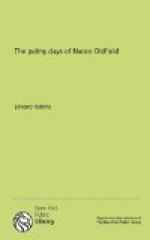To leave the merry days of Charles II, and wander back to those of Queen Anne, it may be said that Ryan made his first success as the Marcus in the original production of “Cato.” It was a success rather added to than otherwise by an adventure of which this actor was the unfortunate victim. “In the run of that celebrated tragedy,” writes Chetwood, “he was accidently brought into a fray with some of our Tritons on the Thames; and, in the scuffle, a blow on the nose was given him by one of these water-bullies, who neither regard men or manners. I remember, the same night, as he was brought on the bier, after his suppos’d death in the fourth act of ‘Cato,’ the blood, from the real wound in the face, gush’d out with violence; that hurt had no other effect than just turning his nose a little, tho’ not to deformity; yet some people imagine it gave a very small alteration to the tone of his voice, tho’ nothing disagreeable.” And a very good advertisement it was, no doubt.
In later years another much-discussed accident befell Mr. Ryan. As he was going home from the theatre one night, the actor was attacked by a footpad, and received in his face two bullets which broke a portion of his jaw. “By the help of a lamp [again is the quotation from Chetwood] the robber knew Mr. Ryan, as I have been inform’d, begg’d his pardon for his mistake, and ran off. Of this hurt, too, he recover’d, after a long illness, and play’d with success, as before, without any seeming alteration of voice or face. His Royal Highness, upon this accident (was it the Prince of Wales, afterwards George II?) sent him a handsome present; and others, of the nobility, copy’d the laudable example of the second illustrious person in the three kingdoms.”
This was Lacy Ryan, who in his time played many different parts, among them Iago, Hamlet, Macduff, Captain Plume, and Orestes. He was not in any sense of the word a great actor, but he well adorned the station of theatrical life in which it had pleased heaven to place him, and strutted his lengthy hour upon the stage with much satisfaction to his companions and the public. Even when Ryan had to kill a bully in self-defence (it was a fellow named Kelly, who loved to haunt the coffee-houses, pick quarrels with peaceable citizens, and then half murder them), the world looked on approvingly, and averred that the player had acted with his usual conscientiousness.
Another contemporary of Nance was Benjamin Johnson,[A] who achieved curiously enough some of his greatest successes in the plays of his namesake, the other Ben Jonson. He began life as a scene painter, but afterwards turned his attention to the front, rather than the back, of the stage—or, as he would humorously explain, “left the saint’s occupation to take that of a sinner.” Johnson seems to have been a man of the world, and he saw a good deal of life, even though he never passed through the rough-and-tumble adventures of Lacy Ryan. When he was born (1665) Betterton dominated the boards; when he died (1742) Garrick had become the talk of London; and it is probable that in his latter years Ben could tell many a story of interesting experiences.




